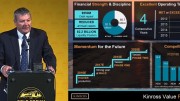Back in May 2013, as we editorialized about the still-fresh merger of trading house Glencore and mining major Xstrata — a deal creating a US$70-billion company that still ranks as the largest M&A move in mining history — we pondered about “the inherent contradictions of this merger, which is attempting to fuse a trader’s short-term, amoral, zero-sum game ethic with a mining company’s much longer time horizon and ever-increasing requirements to be a good corporate citizen in its host countries.”
This month we know the inherent contradictions couldn’t hold up even three years. Plummeting commodity markets over the past year — particularly for copper and thermal coal — have evaporated Glencore’s profits from its too-often marginal asset base, and exposed for all to see the firm’s worryingly large debt levels.
The worst day for Glencore shareholders was the nadir of Sept. 28, when shares on the London Stock Exchange dropped 29% in a day to close at just 68.62 pence, compared to 298p on Dec. 31, 2014 (a 73% decline), and 530p at the firm’s initial public offering in 2011 (an 87% decline).
However, at press time on Oct. 6, Glencore shares had roared back to 118p for a stunning 72% return in eight days for anyone smart, brave or lucky enough to have jumped into the stock at the perfect time. Glencore’s market capitalization is US$20.6 billion at the moment, up from US$11.6 million only eight days earlier, but still a far cry from the US$70 billion enjoyed in May 2013.
Beyond that crazy rollercoaster ride for the stock price lie some sobering financials. Over the first half of 2015, Glencore lost US$676 million and passed the half-year mark carrying US$29.6 billion in net debt, not including debt inside its trading arm. That compares with the net debt of US$24.4 billion for BHP Billiton and US$13.7 billion for Rio Tinto.
Glencore has particularly pressing reasons for keeping its debt under control, as its trading arm relies on the wider firm keeping investment-grade debt ratings in order to make the most profitable trades.
Front and centre through it all has been Glencore’s hard-nosed chief executive Ivan Glasenberg, who hasn’t let up in his criticism of his rivals for not reining in production to strengthen commodity prices. Glencore has already done so — most notably at its copper mines in Zambia and the Democratic Republic of the Congo — and has suspended its dividend, sold non-core assets, and raised US$2.5 billion in a share offering to get its debt under control. It is now pledging to cut its debt by a third to avert a debt downgrade.
Glasenberg himself has been on a high-paced world tour in recent months, visiting operations and trying to reassure key investors that the company “remains operationally and financially robust,” and is only going through a temporary rough patch.
Glencore has just revealed more details about its finances, stating that it would survive a downgrade two notches to “junk” status, which would increase its payments by 1.25% on US$4.5 billion in bonds, or a relatively modest US$56 million a year.
Still, Glencore investors worry the firm has been less forthcoming about the financial situation at its secretive trading business, which is assumed to regularly use highly levered derivative products that could leave the entire firm vulnerable to wide swings in commodity prices. Glencore has stated that it had US$9.8 billion in gross derivatives in June 2015, compared to US$19 billion six months earlier, and that its trading unit posted adjusted earnings of US$1.1 billion in the first half of 2015. It further emphasized on Oct. 6 that its trading credit lines are still available, with no special conditions attached, and that its trading unit’s derivative positions are settled with cash on a daily basis — and so not to worry.
The surge in Glencore stock in early October indicates the market is buying Glasenberg’s pitch that the firm could soon have its debt problems under control, with better days ahead.



Be the first to comment on "Editorial: Glencore stock crash reverberates across mining sector"